You already know that when sending a resume to a prospective employer, you also need to send a cover letter. But let’s take a close look at what to include in a cover letter — and what not to include — to be sure that it covers all the bases and hits all the right notes.
This guide will discuss the essential elements of what to put in a cover letter, which are listed immediately below and which we will explore in depth here.
For more information, consult our expert guide on how to write a cover letter.
What should be in a cover letter
Here are the essential parts that should be in a cover letter:
- Cover letter header with contact info
- Cover letter greeting: “Dear.…”
- Cover letter introduction: A compelling opening statement
- Cover letter body: The “meat and potatoes”
- Cover letter conclusion: A call to action
- Cover letter sign-off: “Sincerely ...”
Let’s talk about what each of these elements should contain and how to go about writing them. Answering the question of “what to put in a cover letter” is only the first step, you need to now HOW to compose each element and what their purpose is.
Be unapologetic at including your "why" in the cover letter. A cover letter is your chance to get honest and personal with a potential employer. The resume is mostly factual and therefore sometimes a little uninspiring, but the cover letter gives you a chance to let your personal motivations shine through. If the excitement about the potential role does not come across in your cover letter, it is easy to wonder how much you actually want it.
What to include in the cover letter header (contact section)
The cover letter header is the attractively designed space at the top of the page that includes:
- Your name
- Your occupation
- Your mailing address
- Your phone number
- Your email address
- Optional: Your LinkedIn profile or another relevant website
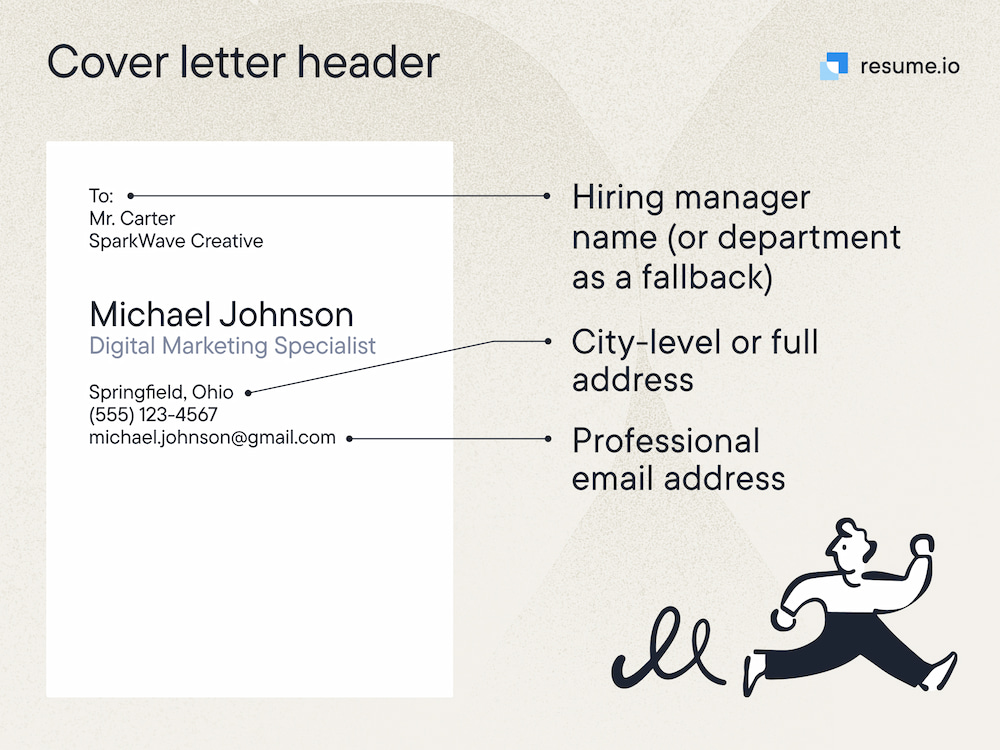
The obvious reason for including all this info is so that prospective employers will know how to reach you if they’re interested. Another function of the header is as a design element that simply makes your page look attractive and eye-catching.

Also, your cover letter header and resume header should have a similar look and design so that it’s obvious they’re meant to go together.
Some header designs put all this info in a horizontal space right across the top of the letter, like this:
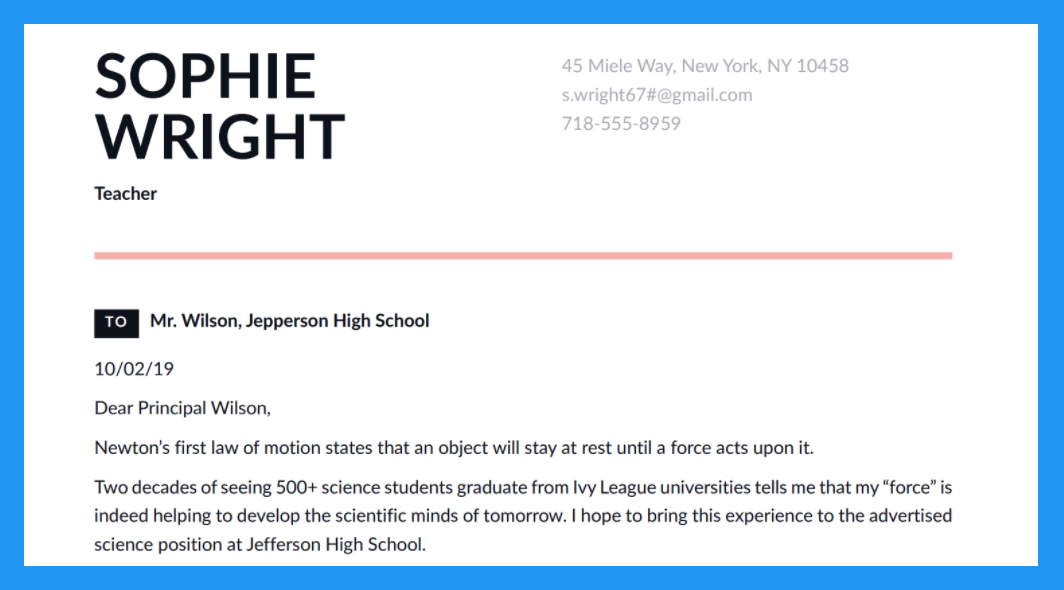
Other designs place the contact info in a “gutter” or “well” on the left or right side of the page, like this:
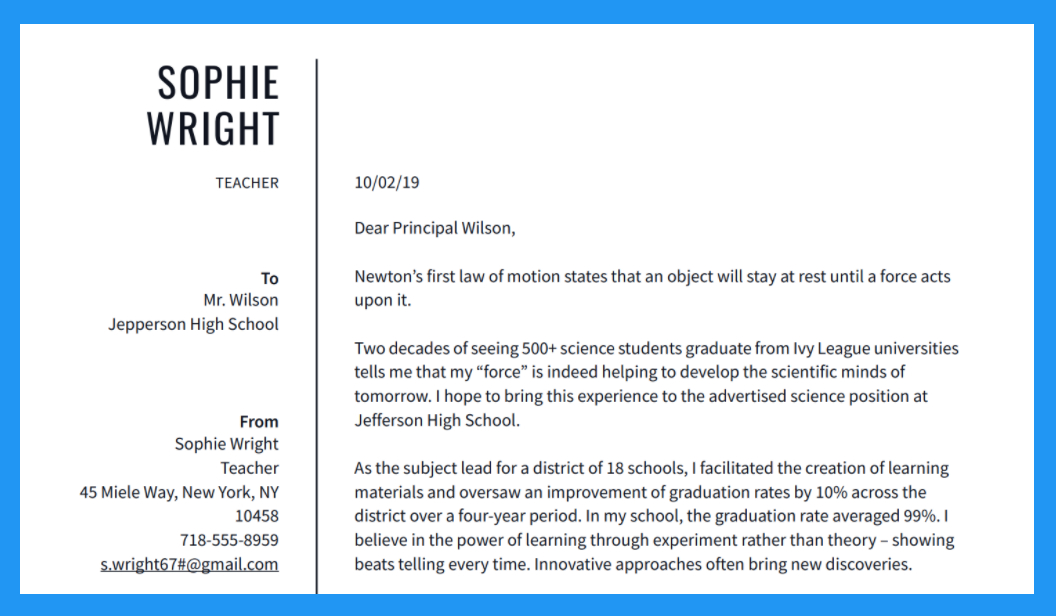
How to choose a cover letter greeting
Also known as a salutation, the cover letter greeting is the single line under the header that usually starts with the word “Dear,” followed by “Mr.,” “Ms.” or “Dr.” and the hiring manager’s last name.
Some cover letter writers choose alternatives to the word “Dear,” such as “Greetings” or even “Hello,” followed by the name of the person. These more casual salutations may be acceptable, depending on the company’s formality or lack thereof in the way it addresses the public. But beware of being too informal, and remember that “Dear” is never a bad choice.
It’s important to try to address your letter by name to the actual person who is processing applications for the job you’re seeking. If this person’s name is not mentioned in the job listing, it’s worth doing some research, or even making a phone call, to find out.
However, in some cases hiring managers may prefer not to release their names, in which case you’ll have to resort to a more generic greeting, like “Dear Acme Corp. Hiring Team.”
If you do know the name of the recruiter, lean toward using that person’s last name, unless you happen to know the person well enough that this formality seems unnecessary.
In formal business correspondence, the greeting should generally be followed by a colon (“Dear Dr. Johnson:”). However, it’s also common to follow the greeting by a comma (“Dear Dr. Johnson,”).
Dear Ms. Alvarado:
Dear Mr. Singh:
Dear Dr. Hughes:
Greetings XYZ Co. Hiring Team,
Cover letter introduction: to help you get the reader’s attention
Your cover letter introduction (the first paragraph, or sometimes two) should immediately capture the hiring manager’s attention, and not for the wrong reasons. You need to hook the fish before you start trying to reel it in.
The introduction should identify the job you’re seeking and provide a compelling preview of the reasons you’re a great candidate for this job. Typically, this will involve mentioning your years of experience in the field. Or if you don’t have much experience because you’ve just graduated from college, then mentioning the degree you just received may be your hook.
Include a pain point as a perfect (and relevant) hook. I understand your issues and here is why I am the person to help you out. No hiring manager can resist that sort of job search pitch, let alone in the introduction of a cover letter. Including a pain point demonstrates that you understand the job and it also shows that you have the confidence in yourself to provide a solution. Confidence is everything in a job search - back yourself.
In some cases, it may be appropriate to mention how you heard of the job, or occasionally even to explain why you’re seeking a new job. And if you know someone who works at the company whom the hiring manager would also know, mentioning that person’s name might be useful.
Use compelling, provocative language, and choose your words with care. Avoid clichés and common phrases the recruiter has seen a thousand times before, like “Please consider this letter my application for….” or “I am writing this letter to….”
Dear Principal Wilson,
Newton’s first law of motion states that an object will stay at rest until a force acts upon it.
Two decades of seeing 500+ science students graduate from Ivy League universities tells me that my “force” is indeed helping to develop the scientific minds of tomorrow. I hope to bring this experience to the advertised science position at Jefferson High School.
What to put in a cover letter body (middle part)
The cover letter middle part or body (the central two to four paragraphs) should contain the “meat and potatoes” of your pitch. Here you must make your case that you are the right person for the job. So, what to put in a cover letter body?
Include bullet points to make your best examples really stand out. If you have an achievement or three that you really want to feature prominently (ideally with a percentage improvement or impressive amount of money next to them), then bullet points are a perfect mechanism to break up the flow of text and draw the reader's eye.
Experience is key, so if you’ve got it, flaunt it. Your resume will list your past employers, but your cover letter should also stress your job-related experience. Don’t just mention where you’ve worked or for how long, but emphasize what you actually accomplished at these jobs. Use facts and figures where possible, like new revenue you generated, percent growth you achieved, number of customers you handled.
Include accomplishments that are illustrated by action verbs. You can only prove that you have what it takes to smash your future role if you share examples of what you have achieved in the past. Including descriptive action verbs within these accomplishments will make them jump off the page. Offer context and quantify the accomplishment where possible - only then can an employer make an informed estimation of potential.
Try to include at least one anecdote, a short little story, about a challenge you faced at a past job and how you resolved it successfully.
It’s always desirable to mention the company you’re writing to, and to explain why you admire this company and how you think you can help make it stronger, more efficient and more profitable. At the very least, this shows that you aren’t just sending out a mass mailing to 50 potential employers, but that you want to work for this employer.
Cover letter example: The body
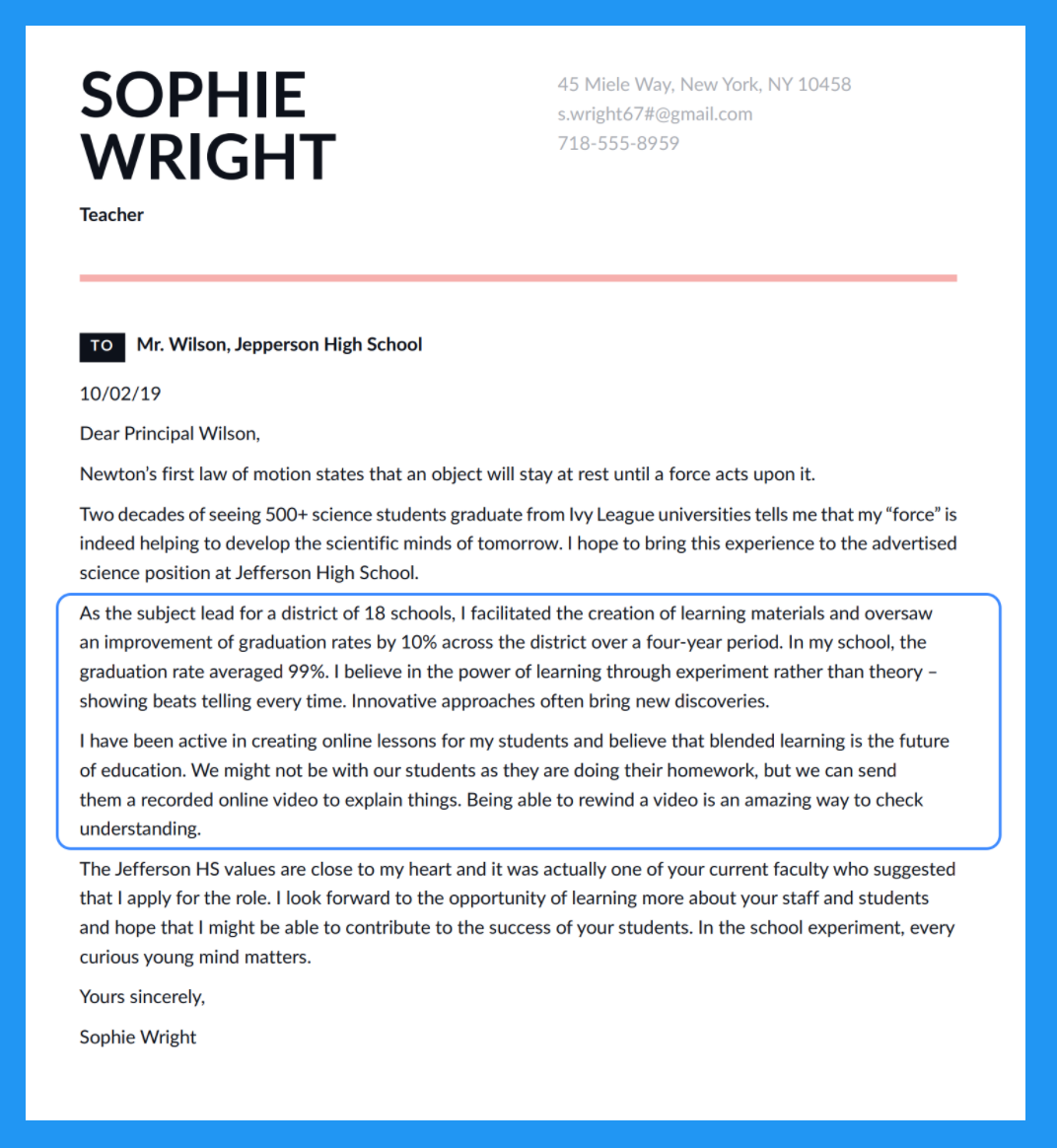
What goes into a cover letter ending?
You’ve hooked the fish and reeled it in; now it’s time to pull it into the boat. Your cover letter ending (conclusion), the final paragraph, should wrap up and summarize your pitch. But it should also include a call to action that encourages your correspondent to do something as a result of this letter.
Include a call-to-action that indicates a certain amount of urgency. While you should never be too arrogant with the last few words of your cover letter, saying that you are looking forward to the potential of an interview soon also hints at the fact that you will have other opportunities. You obviously want to be sitting there with a few offers in your inbox, so why be non-committal and coy about your chances? If you don't ask, you don't get.
At the very least, you could say that you are eagerly waiting for a reply. You might mention that you are always reachable at the contact info provided. You could say that you would be delighted to schedule an interview, whether in person or remotely. You may even want to ask if it would be all right for you to call the recruiter within the next week or two to follow up. Without being demanding or presumptuous, let this person know that you really expect a reply of some kind and you’re really looking forward to it.
Cover letter content: The conclusion.
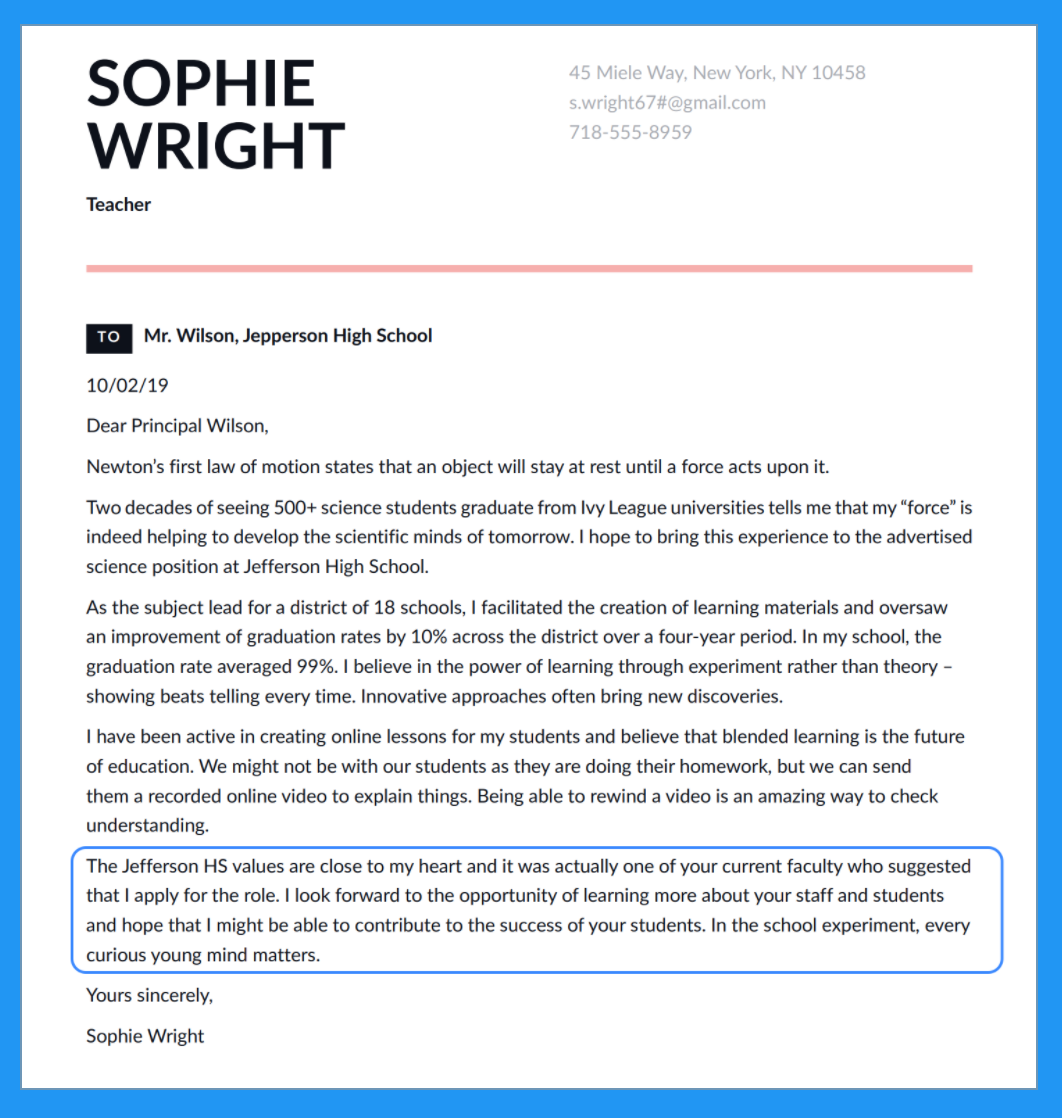
Cover letter sign-off and signature: ‘Sincerely….’
The cover letter sign-off, or closing salutation, is the single line that says “Sincerely” or some equivalent phrase, like “Best regards” or “Thank you for your time.” Sort of like the greeting “Dear,” the closing “Sincerely” is never inappropriate and makes a good default. But there are a few acceptable alternatives — just avoid anything too casual, or anything that might sound odd.
Whatever phrase you choose, put a comma after it, add a space, and type your full name below that. If you’re preparing a hard copy of your cover letter, you need to sign it in the space between the sign-off and your typed name. This isn’t necessary in electronic correspondence, although you can add a digital signature here if you like.
Yours sincerely,
Sophie Wright
What should a cover letter say?
Those are the essential ingredients of any cover letter. But people still wonder, in a broader sense: What should a cover letter say? What is the overall goal, and what kind of cover letter content meets the desired objectives?
The goal of the cover letter is to make such a persuasive pitch for your candidacy that a hiring manager will find you impossible to ignore. Your resume will already have a “just the facts” recitation of your employment history, education and skills. Your cover letter will allude to some of this same information, while stressing the qualifications that are most important. But your cover letter should also humanize you and make you sound like somebody the recruiter would really want to meet.
I understand the job, I would be great at the job, I want the job. Including those three sentiments is crucial for any impactful cover letter. Oh, and not forgetting you'd enjoy working with me while I do the job. You should obviously not say these things in so many words, but 200-400 words is more than enough to convey a sense of these feelings. A cover letter is a little like a love letter - it has to leave the reader feeling all kinds of ways.
A cover letter is an attempt to establish a personal connection with a hiring manager — a human being whose help you desperately need if you hope to get a job. Hiring decisions aren’t made by computers or robots, they’re made by human beings. And you need to write your cover letter like you’re also a human being — warm, interesting, passionate, talented and likeable.
Nobody wants to hire someone they don’t like. So be very careful that the tone of your letter never makes you sound arrogant, presumptuous or egotistical. Confident, yes, but not overconfident. It’s important to find the right “voice” for your letter.
When should you review a cover letter?
As each cover letter should be written bespoke for each role, the letter should be reviewed every time you apply for a fresh job. Hiring managers can tell when they read a generic cover letter and it isn't hard to sense that someone doesn't care so much about the role if their cover letter reads like it was written for another position.
It is likely that you will apply for 10s or even 100s of roles, so make cosmetic changes for the roles that you are less keen on, while adopting a forensic approach to editing for the potential dream jobs.
Pay particular attention to the details of the experiences that you are sharing. Are these the sorts of things that you will be expected to do in the job in question? Check each sentence off against the job description and do not be afraid to make wholesale changes if required. Cutting out your "best" achievements is fine if they will not impress the hiring manager. You can mention them during an interview, by all means, but you need to get there first.
What NOT to include in a cover letter
To address the common question of what not to include in a cover letter, first we would say: a second page. A cover letter should almost always be one page only. So trim the fat, keep it lean, and leave out anything that doesn’t advance your objective of getting the hiring manager to call you in for an interview.
Hobbies and interests that have nothing to do with your occupation should rarely be mentioned in a cover letter. Nor do you need to include a complete list of all your past jobs and educational achievements — that should be in your resume.
One word that you should not leave out of your cover letter is the personal pronoun "I." Including as much intimate detail about yourself is the key to a heartfelt cover letter, and while the formal resume might be written in the third person, writing about yourself directly in the first person is essential. It is not unprofessional, it is simply a way of allowing the reader that little bit closer to your essence. Be yourself - everyone else is taken.
If you’re a “self-starter” who “thinks outside the box,” leave these clichés out of your resume. Also, avoid “fluff,” which is language that sounds fancy but really says nothing. Hone your prose so that every word serves a purpose, and delete every word that doesn’t.
In other words: Make your cover letter short — and then make it shorter.
Key takeaways
A cover letter is an intimate and personal appeal to a hiring manager. Get it right and you can improve your chances of securing that magical interview invite. Get it wrong and your application will be quickly forgotten.
- Include your personal "why" and hook the hiring manager with reasons to hire you.
- Use powerful language such as action verbs and mirror the job description where possible.
- Use devices such as bullet points to make your accomplishments stand out.
- Tell only the most relevant career stories and tailor every cover letter for the role.
- You understand the job, want the job, would be good at the job and would be fun to work with.
Resume.io is a leading provider of cover letter templates and occupation-specific cover letter examples and writing guides. You can rely on our expertise to steer you down the right road, and you can choose from over 100 sample cover letters to find a design you like. Click on any of them, and our easy-to-use cover letter builder tool will guide you through the steps to making it your own.
Best of luck in your job search!







